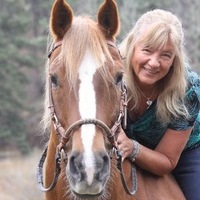
The Most Popular Horse Breeds Of 2019
Equestrian Advice & Guides General Equestrian
Build your business profile for FREE and expose your services to thousands of potential clients!
Create my profile now!
Darby is a horse that people might take for dull or aloof. He’s neither. He’s quite sensitive and worries a lot, so he stays quiet, stands back, watches. And waits. He was not a happy horse when I met him nine years ago; he and his last owner vacillated between not liking, and downright hating each other. They argued about everything from being caught to trailer loading to saddling to picking up his feet, to standing for mounting. It was a bad match, pure and simple. Or was it?
What if, instead of being a bad match, it’s more a matter of communication and crossed wires? If Darby understood this man and vice-versa, would they have sailed through all the human-horse activities happily? And how did Darby tell this guy that he didn’t like him?
Darby didn’t like to be caught and seemed like he’d rather eat dirt than be with his owner. Darby didn’t actively avoid the man until he saw the halter or rope in his hand. And even then, he didn’t usually run away, he sauntered, with one ear cocked to the person and the other looking for a way out. Once caught, his expression changed into a sort of disgusted scowl and he turned rather robotic and stiff in all his movements.
When the two did get into an argument over something like trailer loading, Darby would shut down; his eyes went vacant and he stood his ground. If his owner tried to “make” Darby move forward, that’s when the fights started. First the horse would balk, the man would grimace, growl and chase him with a rope or wave a whip threateningly. Darby would back up, the man would hold tighter and lean back, the horse reared, and the red-faced man pulled harder. It was like watching a very unfair game of tug of war, but with underlying anger and a whole lot of angst from both sides.
All in all, not a pretty picture and yet one seen so often. The horse gets labeled as rank, sour, uncooperative, disrespectful, no good, stupid and any number of other adjectives. But is that even fair? I don’t believe it is, so I bought the horse and now, you’d not recognize him.
First of all, he happily and readily comes when called by name and even runs in from pasture when he hears my voice. His eyes are soft and his ears no longer pin towards humans. He self-loads and stands calmly for mounting. He hasn’t reared in nine years because there is no reason for him to. He nuzzles people and politely asks for treats, but isn’t ever pushy. He leans his head in for a hug and he nickers in greeting.
Ao, what was the deal and why the change? The problem was, Darby didn't want to work for his past owner, and I knew the reason was his fear of the man. He didn’t act afraid, he showed his fear as balkiness, sulkiness and lack of motivation until pushed to the point that he felt he needed to fight back to be heard. Then, he was considered dangerous, unruly, disrespectful, etc., etc., etc.
Which leads to the fact that communicating with horses is truly all about interpretation, isn't it? How a message is sent to the other is so often misunderstood--whether with human to human or animal to human or human to animal. The thing I observe most often is this inability for humans to understand an animal's body language. For example, most people feel they "get" dogs and then buy a horse and believe his body language to mean the same as in a dog. But horses and dogs are so different that people confuse the languages and end up speaking something that resembles "Dorgse" which no-one can comprehend. It's all about communication at the end of the day—the real meaning behind the action or words.
So, how do we develop good communication skills with another species? Well, try the W.R.I.N.K.L.E. Method! Here it is:
Contact me anytime through www.TanyaBuck.com if you’d like to share your stories; I’d love to hear them!
And here’s a FREE tip sheet on buying a horse if you can’t meet them in person. (Covid, you know…) PLUS, you’ll be signed up to receive other free goodies, discounts on books and you’ll get updates on new releases! Click here:
https://lp.constantcontactpages.com/su/n6XsN6X/BuyingBlind
Love your horse, Happily Ever After,
~Tanya Buck

